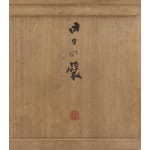Yagi Kazuo (1918–1979)
Folds of the Everyday
Ceramic
With a box signed by the artist
D26.5 x W24.5 x H28.5 cm
Further images
Folds of the Everyday is a bit puzzling to approach: only parts of the material have turned black, which in Japanese pottery is often regarded as a firing failure. Even today, many artists and critics continue to think like this. Yet somehow, one expects there should be more works of this type by Yagi Kazuo, though one rarely encounters them in exhibitions or collections.
The ceramist Yorigami Munemi, who worked at Yagi’s studio for about two years, around 1983 accidentally broke some ceramics that were still work in progress. He rearranged the pieces from fragments in different colors such as black or white or whatever variation occurred during firing, then fired them again and called the results Re-Creations. Thinking about how Yorigami came up with this truly modern idea, it appears plausible he had seen objects by Yagi such as Folds of the Everyday where only parts are blackened, and then emulated the approach.
Yorigami’s Re-Creations reflect an artistic intention, but in the case of Yagi’s Folds of the Everyday, it is not as obvious if the partial black color was planned or accidental. Just from looking at it, one suspects that Yagi did not start from an idea or structure and then selected materials and technique, but rather he might have surrendered himself to the clay, resulting in these folds that appear to multiply themselves in the final shape of the object.
Firing at 800-900 degrees Celsius and smoldering pine needles, sawdust and rubber in the kiln, the material would absorb the soot, resulting in the black appearance. The technique, known as black pottery, has been practiced in China since ancient times. Yagi perhaps used pine needles to achieve the desired result. It seems that in search for a new standard of form, the artist applied the black pottery technique only partially. Since on Folds of the Everyday the demarcation between the black and the lighter-colored areas runs diagonally across the object, he must have placed it on a slanted surface. During the firing one part of it was exposed to temperatures high enough to produce the black hue, while the other was not. This eagerness to experiment is among the reasons why Yagi’s creativity continues to command recognition.
In order to assess the date of the object, it is important to know that Yagi began to work in the black pottery style in 1957. Work at the Kanagawa Prefectural Museum of Modern Art, dated 1963, is partially black. Because of the additional aspect of the diagonal application of the black areas in Folds of the Everyday, we are justified to assume a slightly later date of around 1965.
Yagi Kazuo (ceramist; 1918–1979)
Ceramist from Kyoto. As a co-founder of Sodeisha (Crawling through Mud Association), Yagi was largely responsible for establishing and popularizing non-functional objets as a major category of postwar Japanese ceramic art. Working in Shigaraki clay for much of his career, Yagi later turned to “black pottery” (kokuto). He taught at the Kyoto City University of the Arts.
The ceramist Yorigami Munemi, who worked at Yagi’s studio for about two years, around 1983 accidentally broke some ceramics that were still work in progress. He rearranged the pieces from fragments in different colors such as black or white or whatever variation occurred during firing, then fired them again and called the results Re-Creations. Thinking about how Yorigami came up with this truly modern idea, it appears plausible he had seen objects by Yagi such as Folds of the Everyday where only parts are blackened, and then emulated the approach.
Yorigami’s Re-Creations reflect an artistic intention, but in the case of Yagi’s Folds of the Everyday, it is not as obvious if the partial black color was planned or accidental. Just from looking at it, one suspects that Yagi did not start from an idea or structure and then selected materials and technique, but rather he might have surrendered himself to the clay, resulting in these folds that appear to multiply themselves in the final shape of the object.
Firing at 800-900 degrees Celsius and smoldering pine needles, sawdust and rubber in the kiln, the material would absorb the soot, resulting in the black appearance. The technique, known as black pottery, has been practiced in China since ancient times. Yagi perhaps used pine needles to achieve the desired result. It seems that in search for a new standard of form, the artist applied the black pottery technique only partially. Since on Folds of the Everyday the demarcation between the black and the lighter-colored areas runs diagonally across the object, he must have placed it on a slanted surface. During the firing one part of it was exposed to temperatures high enough to produce the black hue, while the other was not. This eagerness to experiment is among the reasons why Yagi’s creativity continues to command recognition.
In order to assess the date of the object, it is important to know that Yagi began to work in the black pottery style in 1957. Work at the Kanagawa Prefectural Museum of Modern Art, dated 1963, is partially black. Because of the additional aspect of the diagonal application of the black areas in Folds of the Everyday, we are justified to assume a slightly later date of around 1965.
Yagi Kazuo (ceramist; 1918–1979)
Ceramist from Kyoto. As a co-founder of Sodeisha (Crawling through Mud Association), Yagi was largely responsible for establishing and popularizing non-functional objets as a major category of postwar Japanese ceramic art. Working in Shigaraki clay for much of his career, Yagi later turned to “black pottery” (kokuto). He taught at the Kyoto City University of the Arts.





